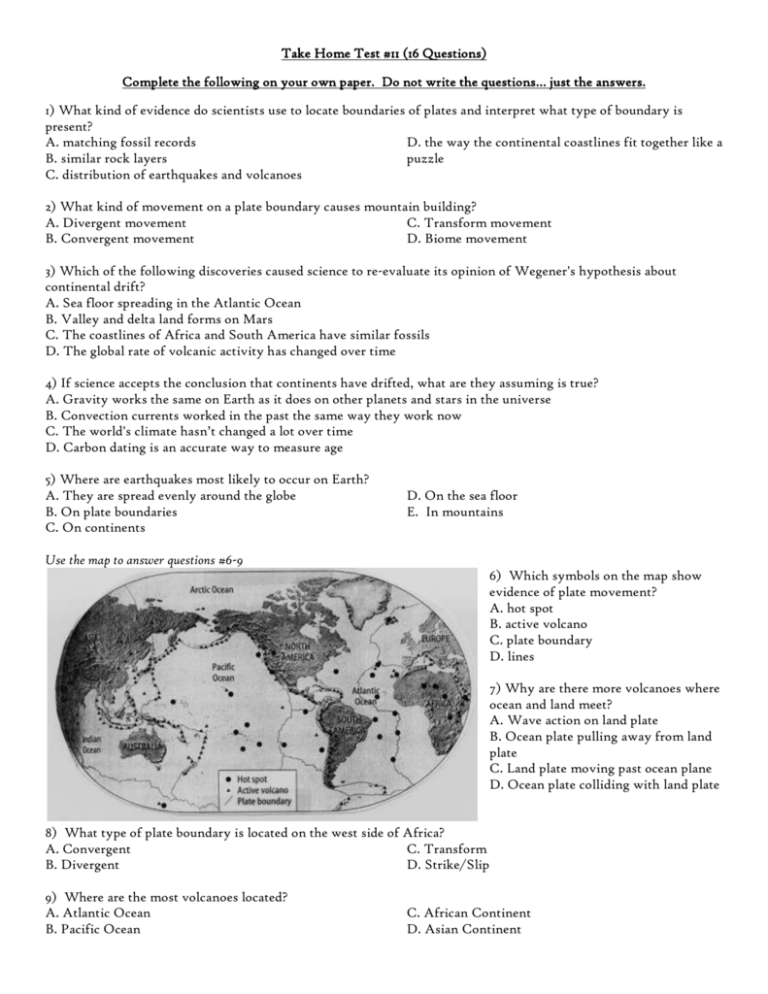Take Home Test #11 (16 Questions) Complete the following on your
advertisement

Take Home Test #11 (16 Questions) Complete the following on your own paper. Do not write the questions… just the answers. 1) What kind of evidence do scientists use to locate boundaries of plates and interpret what type of boundary is present? A. matching fossil records D. the way the continental coastlines fit together like a B. similar rock layers puzzle C. distribution of earthquakes and volcanoes 2) What kind of movement on a plate boundary causes mountain building? A. Divergent movement C. Transform movement B. Convergent movement D. Biome movement 3) Which of the following discoveries caused science to re-evaluate its opinion of Wegener's hypothesis about continental drift? A. Sea floor spreading in the Atlantic Ocean B. Valley and delta land forms on Mars C. The coastlines of Africa and South America have similar fossils D. The global rate of volcanic activity has changed over time 4) If science accepts the conclusion that continents have drifted, what are they assuming is true? A. Gravity works the same on Earth as it does on other planets and stars in the universe B. Convection currents worked in the past the same way they work now C. The world's climate hasn’t changed a lot over time D. Carbon dating is an accurate way to measure age 5) Where are earthquakes most likely to occur on Earth? A. They are spread evenly around the globe B. On plate boundaries C. On continents D. On the sea floor E. In mountains Use the map to answer questions #6-9 6) Which symbols on the map show evidence of plate movement? A. hot spot B. active volcano C. plate boundary D. lines 7) Why are there more volcanoes where ocean and land meet? A. Wave action on land plate B. Ocean plate pulling away from land plate C. Land plate moving past ocean plane D. Ocean plate colliding with land plate 8) What type of plate boundary is located on the west side of Africa? A. Convergent C. Transform B. Divergent D. Strike/Slip 9) Where are the most volcanoes located? A. Atlantic Ocean B. Pacific Ocean C. African Continent D. Asian Continent 10) The earth’s crust is broken into pieces called plates. These plates interact with each other at boundaries. Which of the following is the best data to use when classifying plate boundaries? A. The length of the boundary between the two plates. B. The size of the two plates that meet at a boundary. C. The motion of the two plates relative to each other at the boundary. D. The speed at which the two plates are moving as they meet at a boundary. 11) Alfred Wegener proposed that 200 million years ago, continents broke apart from the supercontinent Pangaea and have drifted apart over time. This idea is known as continental drift. Which of the following is the best fossil evidence for continental drift? A. Fossils of the same land dwelling animals were found on widely separated continents. B. Fossils of the same ocean dwelling organisms were found in different oceans. C. Fossils of the same warm climate organisms were found on continents with warm climates. D. Fossils of the same freshwater organisms were found on areas with abundant freshwater. 12) How has technology changed scientists’ understanding of sea floor spreading and how it is evidence of plate tectonics? A. Earthquakes are evidence of changes in the ocean floor. B. The measurement of the weight of the ocean gave evidence of sea floor spreading. C. The ocean floor was mapped and studied using sonar and magnetometers. D. Scientists used computer measurements of volcanic activity to give details of the ocean floor. 13) Wegener’s theory of continental drift was not accepted until the mid-1900’s. Which of the following are technological advances that led to the acceptance of this theory and laid the ground work for plate tectonics? A. Sonar and magnetometers mapped the ocean floor and detected magnetic striping. B. Satellites created communication networks for scientists on other continents. C. Computer systems were used to simulate tectonic patterns on other planets. D. Seismometers were developed to accurately measure volcanic activity. 14) Which of the following explains the role of Alfred Wegener’s hypothesis of continental drift and the development of the theory of plate tectonics? A. Wegener’s is the only scientist who worked on the continental drift hypothesis. B. A hypothesis usually has more evidence than a theory does. C. Wegener’s hypothesis was contradicted by recent scientific information. D. Evidence over the years has filled in the gaps in the continental drift hypothesis. 15) Consider the following three pieces of data. I. The continents on Earth fit together like a puzzle. II. The same plant fossils are found on many different continents. III. Climate data indicates that some continents in the Arctic once were tropical and warm. Which of the following best describes the relationship between the above statements? A. They are evidence for continental drift. D. There is no relationship. They are separate areas of B. They describe major areas of geologic studies. science. C. They help to explain why the plates on Earth move. 16) Essay (100+ words)--Wegener died on a research expedition in Greenland years before the theory of continental drift, one of the most ridiculed of scientific hypothesis in history, was accepted. Today is no different from the past. Often, scientific theories that are accepted today will be discounted or modified to fit newfound truths in the future. Theories that are rejected now may, in the future, be validated with newly-found evidence. What lesson can we learn from Alfred Wegner and how the scientific community treated him?









